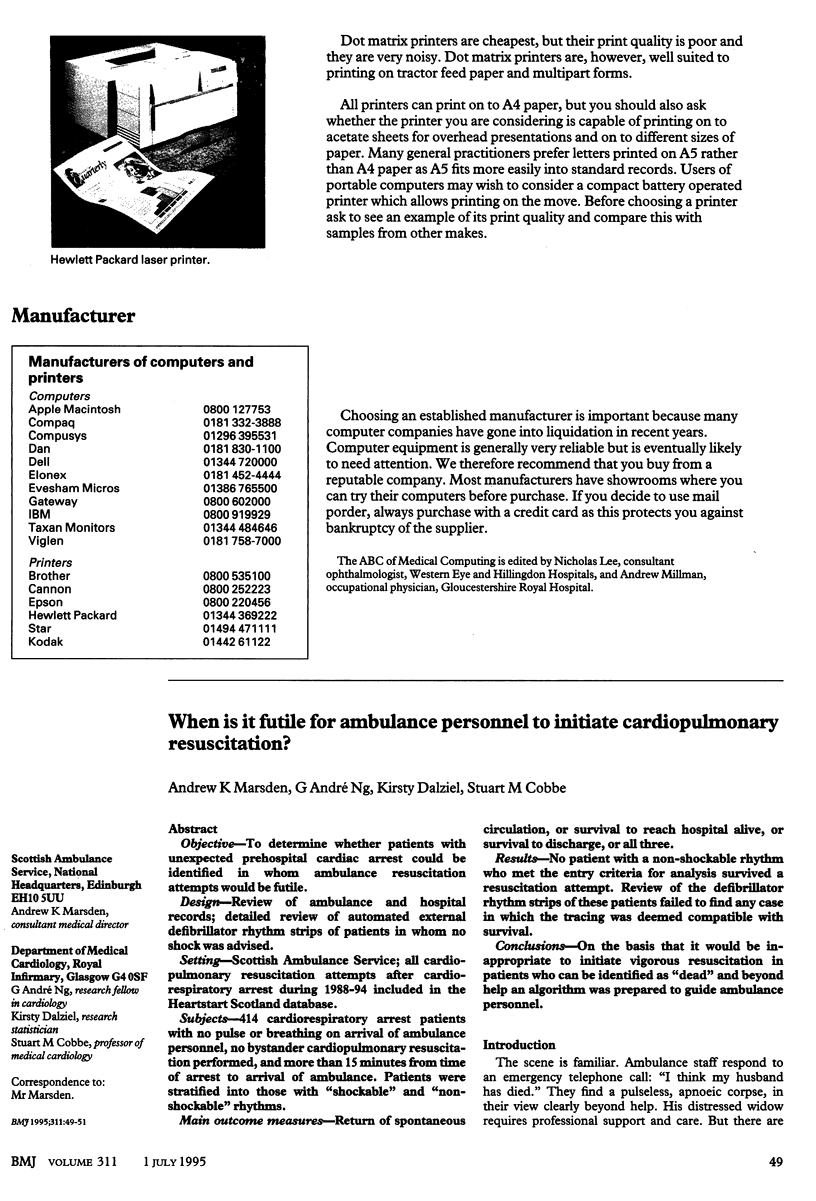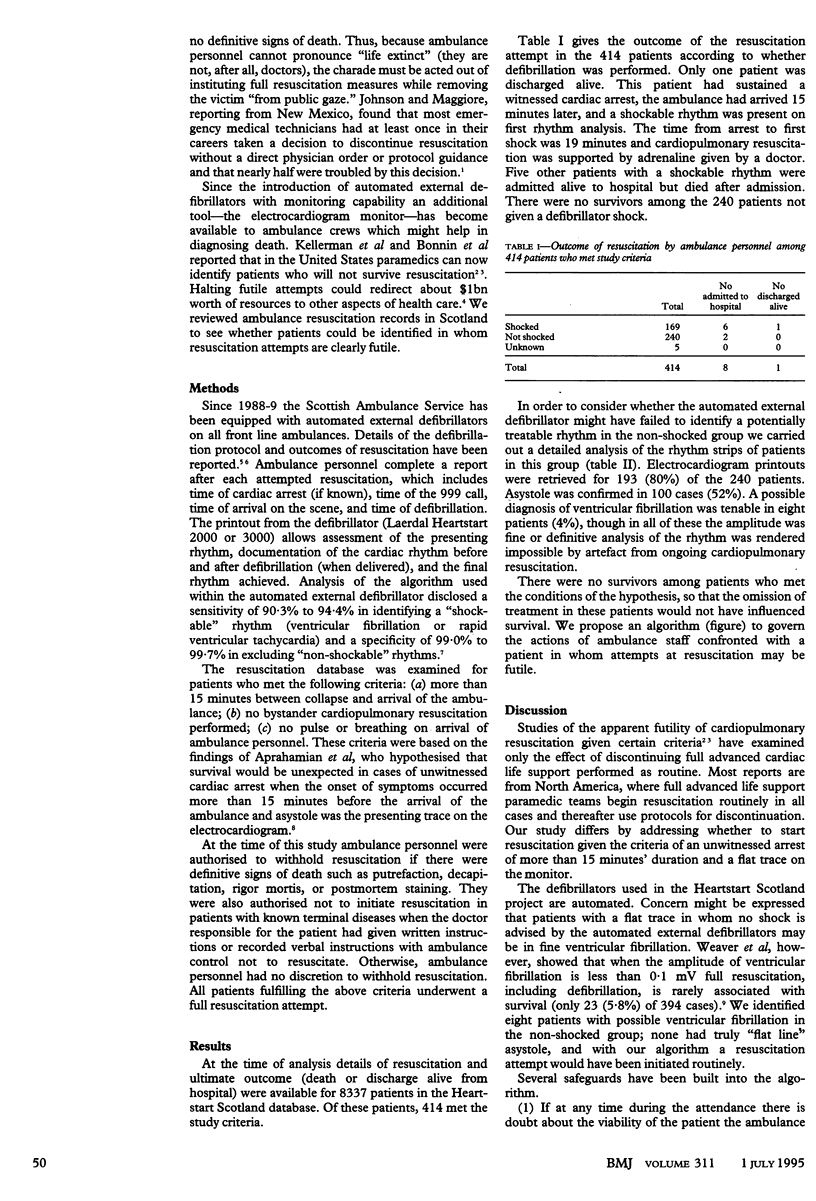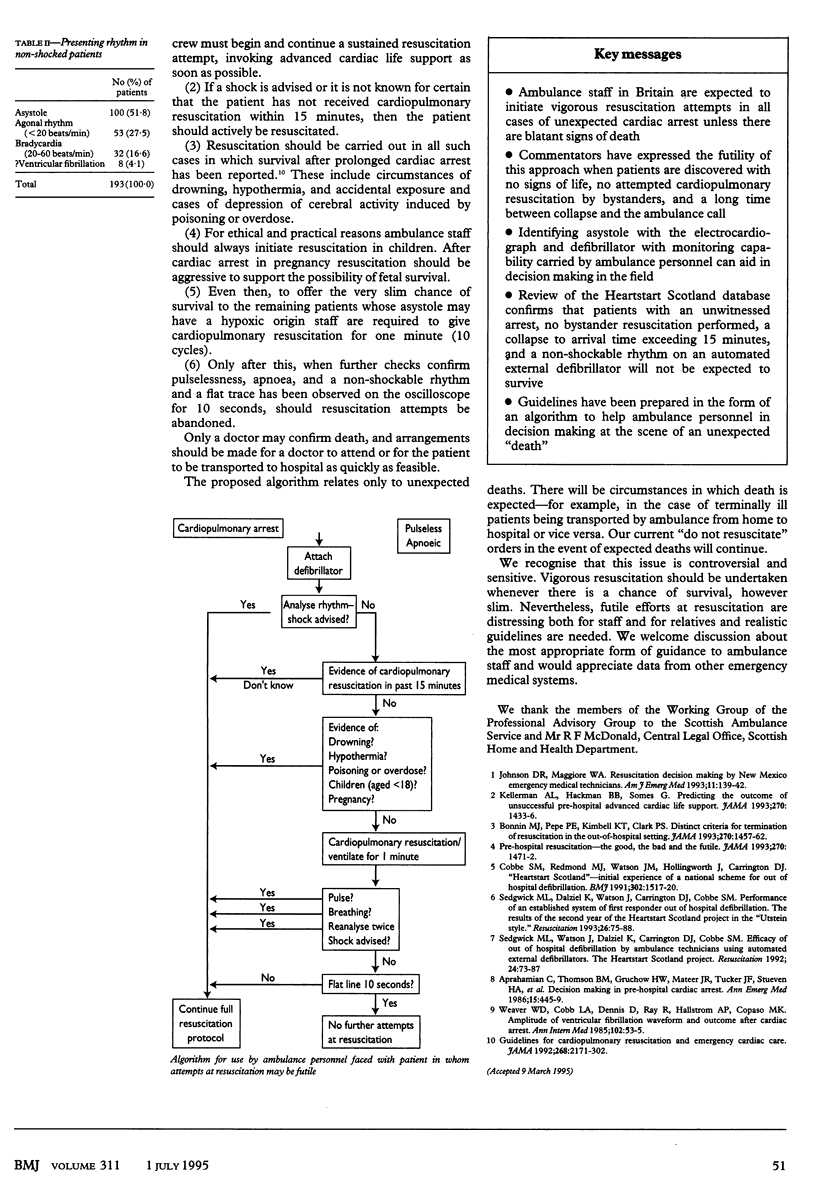Abstract
OBJECTIVE--To determine whether patients with unexpected prehospital cardiac arrest could be identified in whom ambulance resuscitation attempts would be futile. DESIGN--Review of ambulance and hospital records; detailed review of automated external defibrillator rhythm strips of patients in whom no shock was advised. SETTING--Scottish Ambulance Service; all cardiopulmonary resuscitation attempts after cardiorespiratory arrest during 1988-94 included in the Heartstart Scotland database. SUBJECT--414 cardiorespiratory arrest patients with no pulse or breathing on arrival of ambulance personnel, no bystander cardiopulmonary resuscitation performed, and more than 15 minutes from time of arrest to arrival of ambulance. Patients were stratified into those with "shockable" and "non-shockable" rhythms. MAIN OUTCOME MEASURES--Return of spontaneous circulation, or survival to reach hospital alive, or survival to discharge, or all three. RESULTS--No patient with a non-shockable rhythm who met the entry criteria for analysis survived a resuscitation attempt. Review of the defibrillator rhythm strips of these patients failed to find any case in which the tracing was deemed compatible with survival. CONCLUSION--On the basis that it would be inappropriate to initiate vigorous resuscitation in patients who can be identified as "dead" and beyond help an algorithm was prepared to guide ambulance personnel.
Full text
PDF


Images in this article
Selected References
These references are in PubMed. This may not be the complete list of references from this article.
- Aprahamian C., Thompson B. M., Gruchow H. W., Mateer J. R., Tucker J. F., Stueven H. A., Darin J. C. Decision making in prehospital sudden cardiac arrest. Ann Emerg Med. 1986 Apr;15(4):445–449. doi: 10.1016/s0196-0644(86)80185-8. [DOI] [PubMed] [Google Scholar]
- Bonnin M. J., Pepe P. E., Kimball K. T., Clark P. S., Jr Distinct criteria for termination of resuscitation in the out-of-hospital setting. JAMA. 1993 Sep 22;270(12):1457–1462. [PubMed] [Google Scholar]
- Cobbe S. M., Redmond M. J., Watson J. M., Hollingworth J., Carrington D. J. "Heartstart Scotland"--initial experience of a national scheme for out of hospital defibrillation. BMJ. 1991 Jun 22;302(6791):1517–1520. doi: 10.1136/bmj.302.6791.1517. [DOI] [PMC free article] [PubMed] [Google Scholar]
- Johnson D. R., Maggiore W. A. Resuscitation decision making by New Mexico emergency medical technicians. Am J Emerg Med. 1993 Mar;11(2):139–142. doi: 10.1016/0735-6757(93)90107-m. [DOI] [PubMed] [Google Scholar]
- Kellermann A. L., Hackman B. B., Somes G. Predicting the outcome of unsuccessful prehospital advanced cardiac life support. JAMA. 1993 Sep 22;270(12):1433–1436. [PubMed] [Google Scholar]
- Sedgwick M. L., Dalziel K., Watson J., Carrington D. J., Cobbe S. M. Performance of an established system of first responder out-of-hospital defibrillation. The results of the second year of the Heartstart Scotland Project in the 'Utstein Style'. Resuscitation. 1993 Aug;26(1):75–88. doi: 10.1016/0300-9572(93)90166-n. [DOI] [PubMed] [Google Scholar]
- Sedgwick M. L., Watson J., Dalziel K., Carrington D. J., Cobbe S. M. Efficacy of out of hospital defibrillation by ambulance technicians using automated external defibrillators. The Heartstart Scotland Project. Resuscitation. 1992 Aug-Sep;24(1):73–87. doi: 10.1016/0300-9572(92)90175-c. [DOI] [PubMed] [Google Scholar]
- Weaver W. D., Cobb L. A., Dennis D., Ray R., Hallstrom A. P., Copass M. K. Amplitude of ventricular fibrillation waveform and outcome after cardiac arrest. Ann Intern Med. 1985 Jan;102(1):53–55. doi: 10.7326/0003-4819-102-1-53. [DOI] [PubMed] [Google Scholar]



